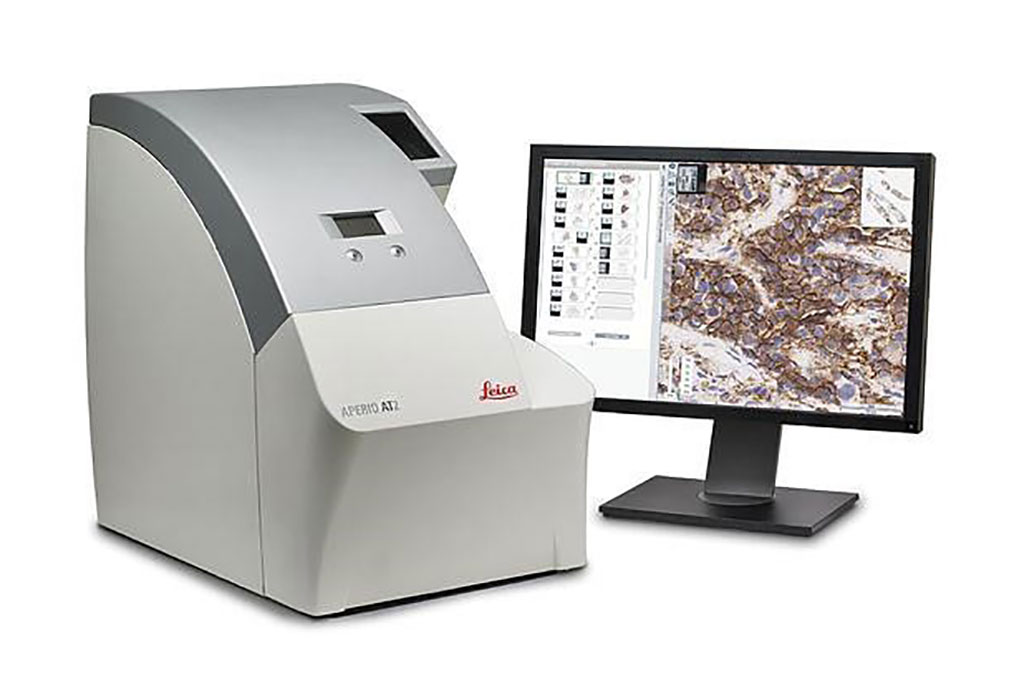Digital Pathology Solution Resolves the Tissue Floater Conundrum
|
By LabMedica International staff writers Posted on 30 Jul 2020 |

Image: The Aperio AT2 is the ideal digital pathology slide scanner for high-throughput clinical laboratories, delivering precise eSlides with low rescan rate (Photo courtesy of Leica Biosystems).
In routine clinical practice, pathologists may encounter extraneous pieces of tissue on glass slides that could be because of contamination from other specimens. These are typically called tissue floaters. The dilemma pathologists often face is whether such a tissue floater truly belongs to the case in question, or if instead it represents a true contaminant from another patient’s sample in which case it should be ignored.
There are currently several measures a pathologist can employ to troubleshoot the tissue floater problem. Akin to forensic analysis, some laboratories have implemented molecular techniques (e.g., DNA fingerprinting for tissue identity testing) to try resolve this problem by dissecting, testing, and then comparing the molecular results of the tissue floater to the adjacent patient sample on the glass slide.
Clinical Pathologists at the University of Michigan (Ann Arbor, MI, USA) and their colleagues demonstrated the feasibility of using an image search tool to resolve the tissue floater conundrum. A glass slide was produced containing two separate hematoxylin and eosin (H&E)-stained tissue floaters. This fabricated slide was digitized along with the two slides containing the original tumors used to create these floaters. These slides were then embedded into a dataset of 2,325 whole slide images comprising a wide variety of H&E stained diagnostic entities. Digital slides were broken up into patches and the patch features converted into barcodes for indexing and easy retrieval. A deep learning-based image search tool was employed to extract features from patches via barcodes, hence enabling image matching to each tissue floater.
All three slides were then entirely digitized at ×40 magnification using an Aperio AT2 whole slide scanner (Leica Biosystems, Richmond, IL, USA). The quality of these digital slides was checked to avoid inclusion of unique identifiers All the slides were then entirely digitized at ×40 magnification using an Aperio AT2 scanner. The quality of these digital slides was checked to avoid inclusion of unique identifiers. These whole slide images (WSIs) included cases from a wide variety of anatomic sites (e.g., colon, brain, thyroid, prostate, breast, kidney, salivary gland, skin, soft tissue, etc.) exhibiting varied diagnostic pathologic entities (i.e., reactive, inflammatory, benign neoplasms, and malignancies).
The scientists reported that there was a very high likelihood of finding a correct tumor match for the queried tissue floater when searching the digital database. Search results repeatedly yielded a correct match within the top three retrieved images. The retrieval accuracy improved when greater proportions of the floater were selected. The time to run a search was completed within several milliseconds. The image search results for matching tissue floaters when using the UPMC 300 WSI pilot dataset showed that the median rank best result for both the bladder and colon tumor was 1 (95% CI =1) when selecting 5% up to 100% of the floater region.
The authors concluded that using an image search tool offers pathologists an additional method to rapidly resolve the tissue floater conundrum, especially for those laboratories that have transitioned to going fully digital for primary diagnosis. The study was published on July 15, 2020 in the journal Archives of Pathology & Laboratory Medicine.
There are currently several measures a pathologist can employ to troubleshoot the tissue floater problem. Akin to forensic analysis, some laboratories have implemented molecular techniques (e.g., DNA fingerprinting for tissue identity testing) to try resolve this problem by dissecting, testing, and then comparing the molecular results of the tissue floater to the adjacent patient sample on the glass slide.
Clinical Pathologists at the University of Michigan (Ann Arbor, MI, USA) and their colleagues demonstrated the feasibility of using an image search tool to resolve the tissue floater conundrum. A glass slide was produced containing two separate hematoxylin and eosin (H&E)-stained tissue floaters. This fabricated slide was digitized along with the two slides containing the original tumors used to create these floaters. These slides were then embedded into a dataset of 2,325 whole slide images comprising a wide variety of H&E stained diagnostic entities. Digital slides were broken up into patches and the patch features converted into barcodes for indexing and easy retrieval. A deep learning-based image search tool was employed to extract features from patches via barcodes, hence enabling image matching to each tissue floater.
All three slides were then entirely digitized at ×40 magnification using an Aperio AT2 whole slide scanner (Leica Biosystems, Richmond, IL, USA). The quality of these digital slides was checked to avoid inclusion of unique identifiers All the slides were then entirely digitized at ×40 magnification using an Aperio AT2 scanner. The quality of these digital slides was checked to avoid inclusion of unique identifiers. These whole slide images (WSIs) included cases from a wide variety of anatomic sites (e.g., colon, brain, thyroid, prostate, breast, kidney, salivary gland, skin, soft tissue, etc.) exhibiting varied diagnostic pathologic entities (i.e., reactive, inflammatory, benign neoplasms, and malignancies).
The scientists reported that there was a very high likelihood of finding a correct tumor match for the queried tissue floater when searching the digital database. Search results repeatedly yielded a correct match within the top three retrieved images. The retrieval accuracy improved when greater proportions of the floater were selected. The time to run a search was completed within several milliseconds. The image search results for matching tissue floaters when using the UPMC 300 WSI pilot dataset showed that the median rank best result for both the bladder and colon tumor was 1 (95% CI =1) when selecting 5% up to 100% of the floater region.
The authors concluded that using an image search tool offers pathologists an additional method to rapidly resolve the tissue floater conundrum, especially for those laboratories that have transitioned to going fully digital for primary diagnosis. The study was published on July 15, 2020 in the journal Archives of Pathology & Laboratory Medicine.
Latest Pathology News
- Rapid Low-Cost Tests Can Prevent Child Deaths from Contaminated Medicinal Syrups
- Tumor Signals in Saliva and Blood Enable Non-Invasive Monitoring of Head and Neck Cancer
- Common Health Issues Can Influence New Blood Tests for Alzheimer’s Disease
- Blood Test Formula Identifies Chronic Liver Disease Patients with Higher Cancer Risk
- Tunable Cell-Sorting Device Holds Potential for Multiple Biomedical Applications
- AI Tool Outperforms Doctors in Spotting Blood Cell Abnormalities
- AI Tool Rapidly Analyzes Complex Cancer Images for Personalized Treatment
- Diagnostic Technology Performs Rapid Biofluid Analysis Using Single Droplet
- Novel Technology Tracks Hidden Cancer Cells Faster
- AI Tool Improves Breast Cancer Detection
- AI Tool Predicts Treatment Success in Rectal Cancer Patients
- Blood Test and Sputum Analysis Predict Acute COPD Exacerbation
- AI Tool to Transform Skin Cancer Detection with Near-Perfect Accuracy
- Unique Immune Signatures Distinguish Rare Autoimmune Condition from Multiple Sclerosis
- Simple Optical Microscopy Method Reveals Hidden Structures in Remarkable Detail
- Hydrogel-Based Technology Isolates Extracellular Vesicles for Early Disease Diagnosis
Channels
Clinical Chemistry
view channel
POC Breath Diagnostic System to Detect Pneumonia-Causing Pathogens
Pseudomonas aeruginosa is a major cause of hospital-acquired and ventilator-associated pneumonia, particularly in lung transplant recipients and patients with structural lung disease. Its ability to form... Read more
Online Tool Detects Drug Exposure Directly from Patient Samples
Doctors often rely on patient interviews and medical records to determine what medications a person has taken, but this information is frequently incomplete. People may forget drugs they used, take over-the-counter... Read moreMolecular Diagnostics
view channel
Blood Biomarker Improves Early Brain Injury Prognosis After Cardiac Arrest
After a cardiac arrest, many patients remain unconscious for days, leaving doctors and families facing uncertainty about whether meaningful recovery is possible. Current tools to assess brain damage, including... Read more
Biomarkers Could Identify Patients at High Risk of Severe AKI After Major Surgery
Acute kidney injury is one of the most common and dangerous complications after major surgery, particularly among patients in intensive care. Even mild impairment of kidney function can lead to long-term... Read more
CLIA Test Identifies Head and Neck Cancer Recurrence from Post-Surgical Lymphatic Fluid
While the lymphatic system’s critical role in metastasis has long been recognized, routine access to patient lymph has been elusive. Now, a non-invasive process can access lymph through the collection... Read moreHematology
view channel
MRD Tests Could Predict Survival in Leukemia Patients
Acute myeloid leukemia is an aggressive blood cancer that disrupts normal blood cell production and often relapses even after intensive treatment. Clinicians currently lack early, reliable markers to predict... Read more
Platelet Activity Blood Test in Middle Age Could Identify Early Alzheimer’s Risk
Early detection of Alzheimer’s disease remains one of the biggest unmet needs in neurology, particularly because the biological changes underlying the disorder begin decades before memory symptoms appear.... Read more
Microvesicles Measurement Could Detect Vascular Injury in Sickle Cell Disease Patients
Assessing disease severity in sickle cell disease (SCD) remains challenging, especially when trying to predict hemolysis, vascular injury, and risk of complications such as vaso-occlusive crises.... Read more
ADLM’s New Coagulation Testing Guidance to Improve Care for Patients on Blood Thinners
Direct oral anticoagulants (DOACs) are one of the most common types of blood thinners. Patients take them to prevent a host of complications that could arise from blood clotting, including stroke, deep... Read moreImmunology
view channelBlood Test Could Detect Adverse Immunotherapy Effects
Immune checkpoint inhibitors have transformed cancer treatment, but they can also trigger serious immune-related adverse events that damage healthy organs and may become life-threatening if not detected early.... Read more
Routine Blood Test Can Predict Who Benefits Most from CAR T-Cell Therapy
CAR T-cell therapy has transformed treatment for patients with relapsed or treatment-resistant non-Hodgkin lymphoma, but many patients eventually relapse despite an initial response. Clinicians currently... Read moreMicrobiology
view channel
Blood-Based Diagnostic Method Could Identify Pediatric LRTIs
Lower-respiratory tract infections (LRTIs) are a leading cause of illness and death worldwide, and pneumonia is the leading infectious cause of death in children under five, claiming the lives of over... Read more
Rapid Diagnostic Test Matches Gold Standard for Sepsis Detection
Sepsis kills 11 million people worldwide every year and generates massive healthcare costs. In the USA and Europe alone, sepsis accounts for USD 100 billion in annual hospitalization expenses.... Read moreRapid POC Tuberculosis Test Provides Results Within 15 Minutes
Tuberculosis remains one of the world’s deadliest infectious diseases, and reducing new cases depends on identifying individuals with latent infection before it progresses. Current diagnostic tools often... Read more
Rapid Assay Identifies Bloodstream Infection Pathogens Directly from Patient Samples
Bloodstream infections in sepsis progress quickly and demand rapid, precise diagnosis. Current blood-culture methods often take one to five days to identify the pathogen, leaving clinicians to treat blindly... Read moreTechnology
view channel
Machine Learning Models Diagnose ALS Earlier Through Blood Biomarkers
Amyotrophic lateral sclerosis (ALS) is a rapidly progressive neurodegenerative disease that is notoriously difficult to diagnose in its early stages. Early symptoms often overlap with other neurological... Read more
Artificial Intelligence Model Could Accelerate Rare Disease Diagnosis
Identifying which genetic variants actually cause disease remains one of the biggest challenges in genomic medicine. Each person carries tens of thousands of DNA changes, yet only a few meaningfully alter... Read moreIndustry
view channel
BD and Penn Institute Collaborate to Advance Immunotherapy through Flow Cytometry
BD (Becton, Dickinson and Company, Franklin Lakes, NJ, USA) has entered into a strategic collaboration with the Institute for Immunology and Immune Health (I3H, Philadelphia, PA, USA) at the University... Read more




















